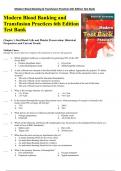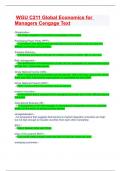Modern Blood Banking & Transfusion Practices 6th Edition Test Bank
Modern Blood Banking and
Transfusion Practices 6th Edition
Test Bank
Chapter 1. Red Blood Cells and Platelet Preservation: Historical
Perspectives and Current Trends
Multiple Choice
Identify the choice that best completes the statement or answers the question.
____ 1. Which metabolic pathway is responsible for generating 90% of the ATP
for the RBC?
a. Pentose phosphate shunt c. Glycolysis
b. Luebering-Rapoport shunt d. Methemoglobin reductase
____ 2. A unit of blood was returned to the blood bank before it was spiked. Apparently the patient’s IV failed.
The unit of blood was outside the blood bank for 35 minutes. Which of the statements below is most
accurate?
a. The unit of blood should be discarded immediately.
b. The unit of blood can be returned to inventory.
c. The unit of blood must be transfused within 4 hours or be discarded at the end of that time.
d. The unit of blood must be transfused with 24 hours.
____ 3. What is the average diameter of a platelet?
a. 5 to 10 µm c. 1 to 2 µm
b. 2 to 4 µm d. 4 to 6 µm
____ 4. In the normal hemoglobin-oxygen dissociation curve, what percentage of oxygen is released to the
tissues when PO2 averages 40 mm Hg?
a. 75% c. 100%
b. 25% d. 50%
____ 5. What factors are known to influence platelet metabolism and function?
a. Storage temperature c. Platelet count
b. Initial pH d. All of the above
____ 6. Which of the following red blood cell morphologies may be present on the peripheral blood smear as a
result of loss of RBC membrane?
a. Spherocytes c. Burr cells
b. Target cells d. Schistocytes
____ 7. What does the term autologous transfusion refer to?
a. A parent donating blood for his or her child
b. An individual donating blood for a friend
c. An individual donating blood for a relative
d. An individual donating blood for his or her own transfusion
____ 8. What is the primary function of hemoglobin?
a. Iron metabolism c. Oxygen transport
b. Porphyrin synthesis d. Signal transduction
, Modern Blood Banking & Transfusion Practices 6th Edition Test Bank
____ 9. All of the following areas of red blood cell biology are crucial for normal erythrocyte survival except:
a. cellular metabolism. c. site of the ABO antigen attachment.
b. RBC membrane. d. hemoglobin structure.
____ 10. What is the correct biochemical composition of the RBC membrane?
a. 52% protein, 40% lipid, 8% carbohydrate
b. 40% protein, 8% lipid, 52% carbohydrate
c. 8% protein, 52% lipid, 40% carbohydrate
d. 8% lipid, 40% carbohydrate, 52% protein
____ 11. All of the following biochemical changes are associated with loss of red blood cell viability upon
storage except:
a. decreased pH. c. increased ATP level.
b. loss of red blood cell function. d. decreased glucose consumption.
____ 12. Which red blood cell preservative has a storage time of 35 days?
a. ACD c. AS-1
b. CPDA-1 d. CPD
____ 13. The RBC membrane is relatively permeable to all of the following except:
a. chloride. c. bicarbonate.
b. sodium. d. water.
____ 14. What percentage of platelets is sequestered in the spleen as functional reserve after being released
from the bone marrow?
a. 30% c. 10%
b. 50% d. 25%
____ 15. What is the major biochemical consideration in platelet storage?
a. Glucose metabolism c. Production of carbon dioxide
b. Oxygen supply d. Regulation of pH
____ 16. What would the hemoglobin-oxygen dissociation curve depict in a patient exhibiting clinical signs of
alkalosis?
a. Normal c. Shift to the right
b. Shift to the left d. None of the above
____ 17. Name the main lipid components of a red blood cell membrane.
a. Phospholipid c. Glycolipid
b. Sphingomyelin d. Glycophorin A
____ 18. The ABO blood groups were discovered in 1901 by whom?
a. Charles Drew c. Loutit and Mollison
b. Karl Landsteiner d. Edward Lindeman
____ 19. A standing order of platelets was shipped to your facility by your supplier. It was inadvertently left in
the corner of the department until discovered 36 hours later. What would the appropriate action be for
the blood banker?
a. If the temperature in the box was 22 +/- 2°C and the platelet swirl seemed OK, it would be
OK to accept the unit into inventory.
b. The platelets have fallen outside the supplier’s quality assurance. The unit should be
discarded because the pH has probably dropped too low and platelet activation has been
compromised.
c. If the temperature was 1°C to 6°C and the platelet swirl seemed OK, it would be OK to
accept the unit into inventory.
, Modern Blood Banking & Transfusion Practices 6th Edition Test Bank
d. If the platelets appeared OK and passed the platelet swirl test after being placed on the
agitator, they could be accepted into the inventory.
____ 20. Which metabolic pathway permits the accumulation of 2,3 diphosphoglycerate (2,3-DPG)?
a. Glycolysis c. Pentose phosphate shunt
b. Luebering-Rapoport shunt d. Methemoglobin reductase
____ 21. All of the following are consistent with a "shift to the right" of the hemoglobin-oxygen dissociation
curve except:
a. increased 2,3-DPG.
b. 50% O2 saturation to tissues.
c. decreased 2,3-DPG.
d. decreased hemoglobin affinity for O2.
____ 22. What is the normal platelet count range per cubic millimeter?
a. 100 to 350 c. 50,000 to 200,000
b. 150,000 to 350,000 d. 350,000 to 500,000
____ 23. What cryoprotective agent is added to red blood cells upon freezing?
a. Dextrose c. Glycerol
b. Adsol d. All of the above
____ 24. If platelets are to be stored for 5 days on a rotator, what is the optimal storage temperature?
a. 1°C to 6°C c. 35°C to 37°C
b. 20°C to 24°C d. 1°C to 10°C
____ 25. What role do platelets play in hemostasis?
a. Maintenance of vascular integrity
b. Initial arrest of bleeding by platelet plug formation
c. Stabilization of the hemostatic plug
d. All of the above
____ 26. Which of the following best describes "integral" membrane proteins?
a. Reside at the cytoplasmic surface of membrane
b. Span the entire membrane surface
c. Form the red blood cell cytoskeleton
d. None of the above
____ 27. How is stroma-free hemoglobin solution prepared?
a. Outdated red blood cells are concentrated, and stroma is removed.
b. Outdated red blood cells are diluted with saline, and stroma is removed.
c. Outdated red blood cells are lysed, and stroma is removed.
d. None of the above
____ 28. What is the normal life span of an RBC?
a. 100 days c. 120 hours
b. 120 days d. 2 days
____ 29. Regarding loss of RBC membrane deformability, all of the following are true except:
a. increase in ATP level.
b. decrease in ATP level.
c. increase in calcium level.
d. decrease in spectrin phosphorylation level.
____ 30. One of the most important controls of hemoglobin's affinity for oxygen is:
a. glucose. c. K+.
b. 2,3-diphosphoglycerate (2,3-DPG). d. Ca++.
, Modern Blood Banking & Transfusion Practices 6th Edition Test Bank
____ 31. The normal position of the oxygen dissociation curve depends on three ligands normally found within
the RBC. Which one of the following is not one of these ligands?
a. H+ ions c. 2,3-diphosphoglycerate (2,3-DPG)
b. CO2 d. Na+
____ 32. Which of the following events does not occur while RBCs are stored?
a. 2,3-DPG levels increase.
b. Potassium levels increase.
c. Hgb has a decreased affinity for oxygen carrying capacity.
d. 2,3-DPG and potassium levels increase.
____ 33. In order to maintain ATP levels in stored blood, ______________ can be added to CPD to extend the
shelf-life of stored RBCs from 21 days to 35 days. This new preservative is designated as CPDA-1.
a. mannitol c. adenine and glucose
b. adenine saline d. Rejuvenix
____ 34. Which type of blood storage container is no longer available for use in the United States because it
may limit the viability of RBCs?
a. Glass bottles c. DEHP-free polyolefin containers
b. PVC plastic bags with DEHP d. Latex-free plastic containers
____ 35. A rare unit of blood became outdated 48 hours ago but is needed for a patient. Which of the following
concepts applies to this situation?
a. The blood could be rejuvenated by adding Rejuvesol, being washed appropriately, and
being transfused within 48 hours.
b. The blood could be rejuvenated with Rejuvesol, washed, and given immediately to the
patient.
c. Once a unit is outdated, it is no longer available for use.
d. The unit can be rejuvenated immediately, washed, and stored in the appropriate
refrigerator until needed later in the week.
____ 36. Hemoglobin-based oxygen carriers have been produced from which of the following sources?
a. Bovine c. Recombinant hemoglobin
b. Human d. All of the above
____ 37. Which of the following statements about perfluorocarbons (PFCs) is not true?
a. PFCs are hydrocarbon structures in which all the hydrogen atoms have been replaced with
fluorine.
b. PFCs carry oxygen and carbon dioxide by dissolving them.
c. PFCs are able to carry oxygen to tissues that are inaccessible, even to RBCs, because of
their small size.
d. PFCs are currently available for use in the United States and several other countries as a
red blood cell substitute.
____ 38. Platelets are anucleated but are composed of organelles. Generally most of these organelles are
composed of cytoplastic granules. When stimulated, which one of these granules would be most
important in satisfying the metabolic need of the platelet?
a. Dense granules c. Lysosomes
b. Alpha granules d. Coarse granules
____ 39. Generally, the quality control measurements required by various accreditation organizations for
platelet concentrates include:
a. platelet concentrate volume and platelet count.
b. leukocyte count if claims of leukoreduction are made.
c. pH of the unit.





